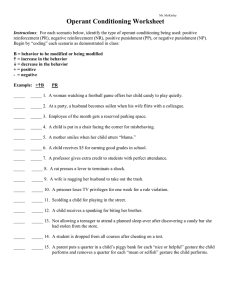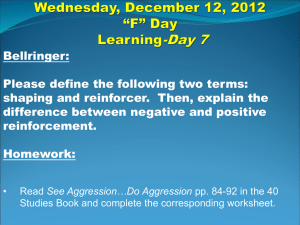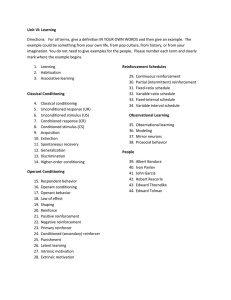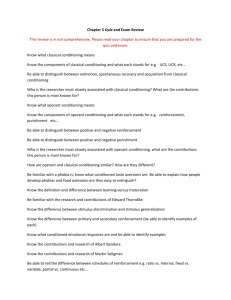AP Psychology Learning Study Guide: Conditioning & Behavior
advertisement
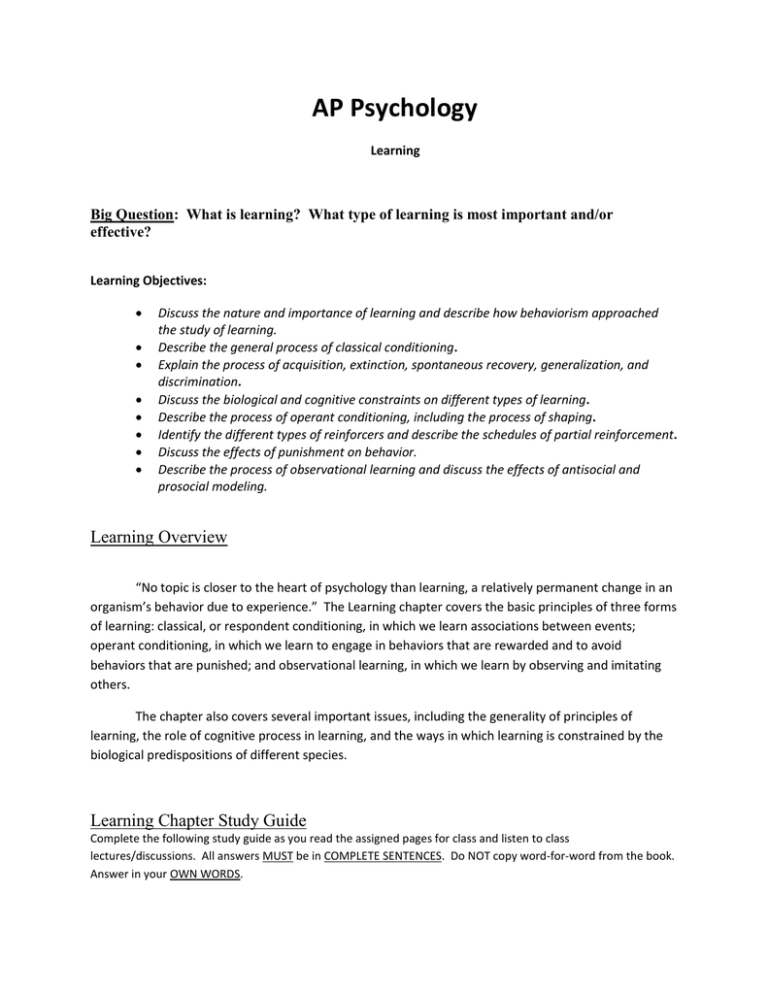
AP Psychology Learning Big Question: What is learning? What type of learning is most important and/or effective? Learning Objectives: Discuss the nature and importance of learning and describe how behaviorism approached the study of learning. Describe the general process of classical conditioning. Explain the process of acquisition, extinction, spontaneous recovery, generalization, and discrimination. Discuss the biological and cognitive constraints on different types of learning. Describe the process of operant conditioning, including the process of shaping. Identify the different types of reinforcers and describe the schedules of partial reinforcement. Discuss the effects of punishment on behavior. Describe the process of observational learning and discuss the effects of antisocial and prosocial modeling. Learning Overview “No topic is closer to the heart of psychology than learning, a relatively permanent change in an organism’s behavior due to experience.” The Learning chapter covers the basic principles of three forms of learning: classical, or respondent conditioning, in which we learn associations between events; operant conditioning, in which we learn to engage in behaviors that are rewarded and to avoid behaviors that are punished; and observational learning, in which we learn by observing and imitating others. The chapter also covers several important issues, including the generality of principles of learning, the role of cognitive process in learning, and the ways in which learning is constrained by the biological predispositions of different species. Learning Chapter Study Guide Complete the following study guide as you read the assigned pages for class and listen to class lectures/discussions. All answers MUST be in COMPLETE SENTENCES. Do NOT copy word-for-word from the book. Answer in your OWN WORDS. 1. You adopt a baby kitten from a nearby farm. On the day you take the kitten home, she has never heard the sound of a can of food opening before. The first few days, you open the can of food, the kitten smells the food, comes running, a nd then eats. By the fifth day, your kitten has learned to come running when the can opens even before you pour out the food. Draw the classical conditioning taking place in the diagram below. Label the UCS, UCR, NS, CS, and CR. 2. Building off the kitten example on the previous page, how would you then extinguish the learned behavior if you wanted to? How would it spontaneously recover? Once recovered, how could you kitten generalize the behavior? How could it discriminate? Be sure to answer all four (4) parts. 3. Refer back to the six ethical principles in conducting experiments that we discussed in class earlier this year. Which of the six principles do you feel were violated in the Little Albert study? Why? 4. Create some real-life examples of positive reinforcement, negative reinforcement, positive punishment, and negative punishment. Be sure to answer all four (4) parts. Hint: Think of school, work, social behavior, etc. for examples. 5. Imagine yourself fifteen years in the future. You have a four-year-old daughter and you’re trying to teach her how to ride a bike. How would you use shaping to train her? Be sure to give specific examples at each stage of the training, not just a general overview. 6. Depressed at the lack of respect his students show him, Mr. Root one day decides to quit teaching and become a professional bodybuilder. He signs a contract with an organization that offers to pay him $25 for each hour he spends in the weight room. What is likely to happen to Mr. Root’s love of weight lifting, and which psychological phenomenon is this known as? 7. Create some real-life examples of being rewarded on the following scales: variable ratio, fixed ratio, variable interval, and fixed interval. Be sure to answer all four (4) parts. Hint: Think of school, work, social behavior, etc. for examples. 8. Based on the results of Albert Bandura’s Bobo Doll studies, what would social learning psychologists say about kids who watch violent movies and television shows while growing up? Do you agree with this view – why or why not? Key Terms Using your own words, write a brief definition or explanation of each of the following. Feel free to be as succinct as possible as long as the definition makes sense to you. Do this after or while reading the assigned pages for class. 1. classical conditioning a. Ivan Pavlov b. unconditioned stimulus (UCS) c. unconditioned response (UCR) - d. neutral Stimulus (NS) e. conditioned Stimulus (CS) f. conditioned Response (CR) - g. acquisition h. extinction i. spontaneous recovery – j. generalization - k. discrimination l. cognitive processes of Classical Conditioning - m. biological predispositions of classical conditioning n. John Garcia studies 2. operant conditioning a. positive reinforcement b. negative reinforcement c. positive punishment d. negative punishment e. limitations of punishment f. Thorndike’s Law of Effect - g. Skinner box h. shaping i. primary reinforcer - j. conditioned (secondary) reinforcer - k. cognitive map l. latent learning - m. overjustification effect n. cognitive processes of operant conditioning o. biological predispositions of operant conditioning p. schedules of reinforcement i. continuous reinforcement – ii. partial reinforcement 1. fixed-ratio 2. variable-ratio 3. fixed-interval 4. variable-interval 3. observational learning a. modeling i. prosocial behavior ii. antisocial behavior b. Albert Bandura’s Bobo Doll Study –



